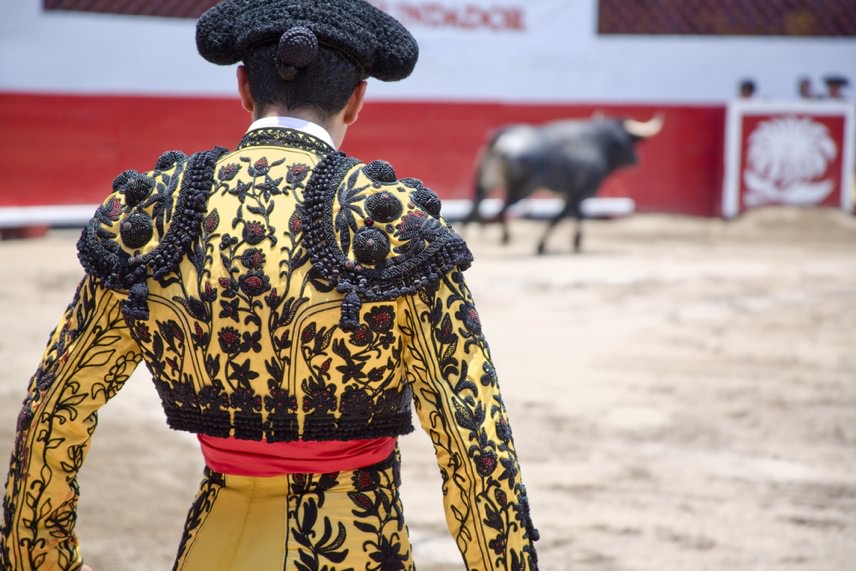
Spain is a country proud of its traditions – but there is one long-held tradition that has been dividing people for hundreds of years. Bullfighting. Its supporters argue it’s a noble cultural art form, while its detractors say it’s a cruel, outdated bloodsport. To help you make up your own mind on bullfighting, we present some common arguments on both sides of the debate.
Fine art or blood sport?
Bullfighting has existed for much of human history, and within Spain it dates back at least 1,000 years. It is considered by many as much an art form as a sport. The event’s flamboyant costumes and baying crowds make it one of Spain’s most globally-recognized traditions, so supporters argue that it’s an important cultural landmark. Those on the other side of the debate, however, counter that tradition and recognition do not make it art. They point to other once-traditional animal sports, from the fierce lion-tiger battles of Ancient Rome to medieval bear-baiting and cockfighting, that we now deem wrong, and ask why bullfighting is any different. Tourists can enjoy colorful clothes and even louder crowds at the Bernabéu.
Killing for fun or killing for meat?
Bullfighting’s detractor’s often refer to bullfighting as mass entertainment. They argue the fighting and eventual slaughter of the bulls is ritualistic, and this “killing for fun” aspect is what clearly distinguishes it from the meat trade. But supporters reply that a bull is usually eaten after a fight, so its death is not in vain. They may even argue that, with vegetarianism a perfectly viable life choice, isn’t anybody who chooses to eat meat only doing it “for fun”?
Fair fight or physical abuse?
A common defense of modern bullfighting is that the animals do not suffer much during the display. A good bullfighter will slaughter it quickly so it has less pain, and if the bull fights valiantly then it may well even be spared its life; in this case, it will be put out to stud. But the counter-argument is that the ritual of bullfighting inflicts unspeakable suffering on the animals, from the confusion and panic created by the crowd noise to the physical abuse the bull will sustain throughout the spectacle. The death might be quick, but the fight is barbaric.
Life of abuse or the good life?
Bullfighting’s opponents often go further still, arguing that the torture and degradation does not only begin when the bull enters the ring. For the previous few days it has been horribly abused; half-blinded, drugged and kept in a dark box. And all to ensure he is ‘primed’ to put on a show. But supporters say that in context, fighting bulls have a good life. They generally live for four to six years, while a meat cow lives for one or two, and they are free to roam on pastures – with full access to veterinary care. The slaughterhouse is actually a far worse fate.
Drain on Spain or economic boost?
A common argument goes that Spain cannot afford bullfighting. The sport is financed with public money, and in 2008 the Spanish fighting bull breeding industry was allocated close to 600 million euros; all at a time when Spain is suffering from a deep and long-lasting financial depression. But others argue that almost all cultural events in Spain are partially funded by public money, but few bring bullfighting’s benefits. The sport employs thousands and brings tourism all across Spain. And it constitutes a total 12 percent of all Spain’s entertainment industry. Rather than Spain being unable to afford bullfighting, it really can’t afford to lose it.
Anti-Spanish or anti-cruelty?
Many bullfighting supporters believe Spain is being unfairly demonized. While the sport is common in Spain, bullfighting takes place around the world. What’s more, large proportions of modern audiences are foreign tourists. Those that criticize animal cruelty in Spain should look at their own country first. Detractors reply that the campaigns are not anti-Spanish, but anti-animal cruelty. The fact is that bullfighting is more popular in Spain than anywhere else, so naturally the spotlight falls there. While many tourists do see a show out of curiosity, few return. And while animal abuse happens in all countries, it’s rarely as institutionalized as this.
Outmoded or in vogue?
Anti-bullfighting campaigners say that polls conducted inside and outside Spain consistently tell us that most people believe bullfighting should be banned. Just look at the vast number of anti-bullfighting campaigns. Even the Catalan Parliament voted to ban bullfighting in 2011 after increased pressure. But the ‘pro’ camp points out that cities across Spain host bullfights throughout summer, when stadiums are full with Spaniards and tourists, while the national television network TVE shows big fights during prime time. Bullfighting is extremely popular.
Over-reaction or vital issue?
Many fans of bullfighting feel this debate gets more air than it should. They say the number of bulls which die each year within Spain is tiny compared to those dying in the meat trade, and many abattoirs kill in more painful and prolonged ways than bullrings. So, they ask, why is so much time spent protesting against bullfighting and not other controversial art forms? Campaigners respond that the fact bullfighting is so blood-thirsty, so widely-known, and so regularly promoted in the media, means it sends out a negative message, both in Spain and beyond. Bringing an end to bullfighting will ultimately help tackle all forms of animal abuse.
Written by: Joseph Reaney
Which side are you on? Is bullfighting a noble, historic tradition that should be preserved, or an archaic, violent sport that must be banned? Share your thoughts in the comments below.

